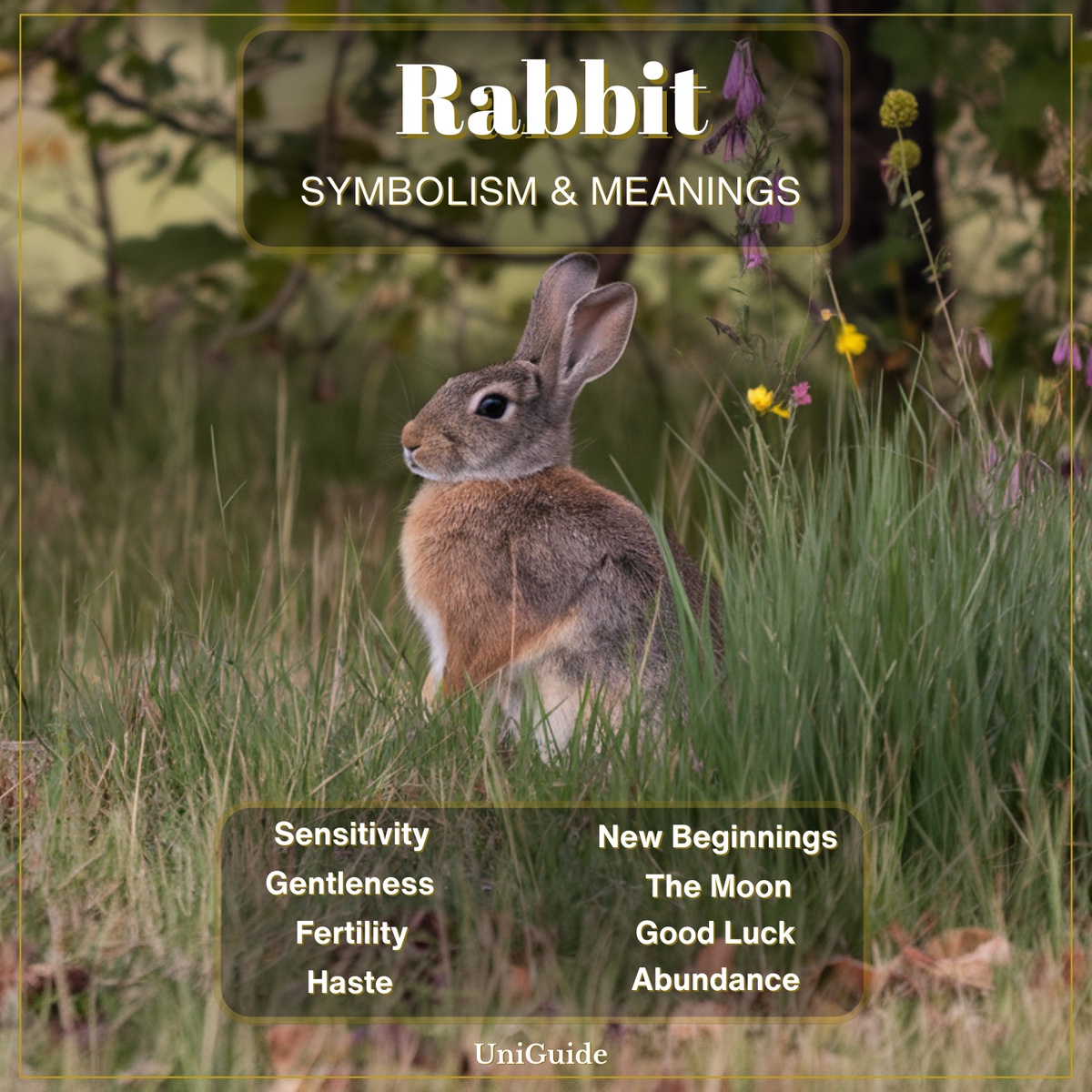
Rabbit symbolism and meanings include sensitivity, gentleness, fertility, haste, new beginnings, the moon, and good luck. Rabbits live on every continent except Antarctica, so they appear in the mythologies and folklore of cultures around the world. In this post, we’ll explore all facets of rabbit symbolism and meanings, including rabbit spiritual meanings and the rabbit spirit animal, as well as that of bunnies and hares. Plus, we’ll explore rabbit and hare mythology and folklore and more.
Table of Contents
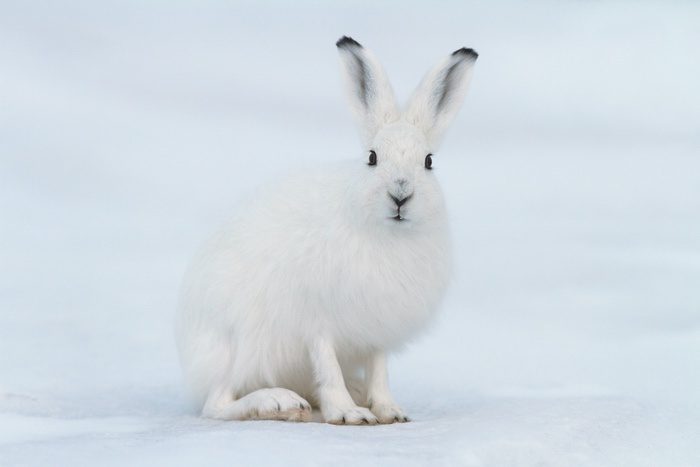
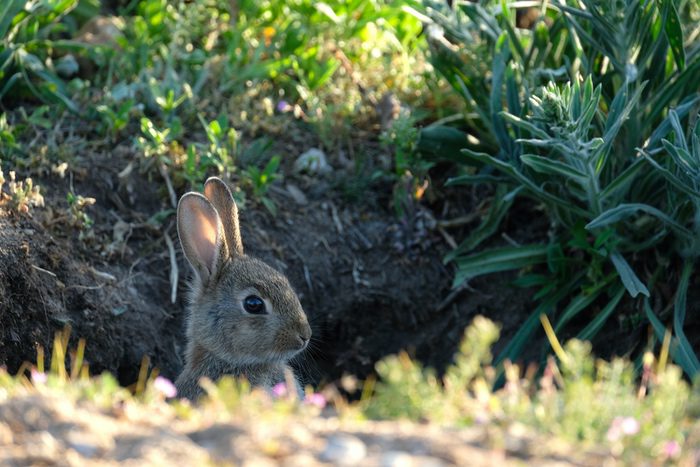
Rabbits are incredibly sensitive animals. As their little noses twitch, they are processing up 20 times the scents that we are.1 In addition, their big ears are designed to pick up on a variety of sounds in their environment, mainly from predators. Where we can hear between 64 hertz and 23,000 hertz, bunnies can hear in a range of 360 hertz to 42,000 hertz.2 Furthermore, rabbits’ big round eyes can see in practically every direction at once.
Because of this, the rabbit is a symbol of sensitivity.
If a rabbit suddenly crosses your path and makes themselves known to you, it can be a reminder to make sure you’re not becoming too desensitized. In many ways, we live in a culture that is intent on numbing us out. Food, alcohol, TV, sleep aids, shopping – all of these activities can cause us to lose touch with our sensitivities and even psychic abilities. While being sensitive can hurt, like the rabbit, we have our senses for a reason. They are our gifts.
If you are a person who already knows the rabbit is your spirit animal, you are likely an extremely sensitive person. While this sensitivity may feel like a burden at times, it’s important to remember that it is indeed a gift. There is a lack of empathy and awareness in the world. And many people are disconnected from each other, from nature, and from their spiritual existence. Sensitive people are the antidote. We keep the world from going too far off the rails.
Bunnies are herbivores who enjoy munching on clover, grasses, wildflowers, and other plants. A gentle creature, the bunny is the polar opposite of predators like the crocodile or shark.
As a symbol of gentleness, the rabbit reminds us to handle others with empathy and compassion. Everyone has battles to fight on their soul’s journey. The rabbit spirit animal says – Go easy.
At the same time, the rabbit reminds us to also treat ourselves gently. Be careful about engaging in negative self-talk and other behaviors that inflict self-harm.
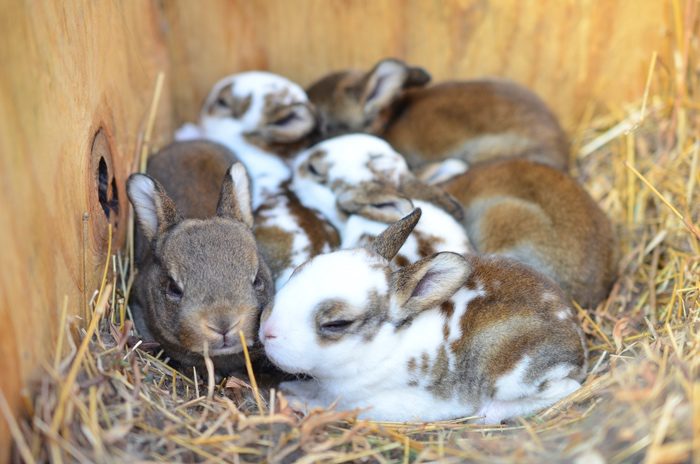
Many of us have heard the phrase “breeding like rabbits.” Indeed, the rabbit is a long-standing symbol of fertility. They get this reputation for a few reasons. One, a rabbit can begin having babies when they’re as young as two months old. And two, they have a gestation period that’s around 27 days. So, a female rabbit can have several litters per year. In addition, male rabbits are not monogamous, so they do as much cavorting as they want, increasing the odds that more female bunnies get pregnant.3
So, if you’re looking for a symbol of fertility, the rabbit is your guy or girl! (The frog is pretty prolific too.)
If you’re hoping to have your own baby or babies, or even thinking of expanding your family through fostering or adoption, including the happy-go-lucky rabbit in your visualizations can put you in the right mindset.
In addition to having babies, the idea of fertility can also expand in scope to the concept of abundance and other areas of your life that you would like to see expand. This might include your finances, creative ideas, dating prospects, a garden, or a new business.
If a rabbit makes themselves known to you, think about the areas of your life that you would like to see grow and send a prayer to your Higher Power or the Universe to make it happen.
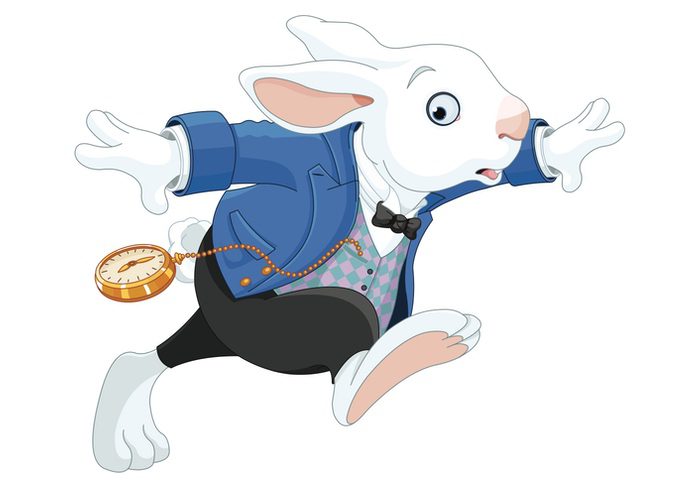
As you may recall in the story Alice in Wonderland, when Alice comes across a white rabbit, he’s in a hurry, claiming, “I’m late, I’m late! For a very important date!”
While the rabbit may not be made for running long distances like the caribou or cheetah, they know how to sprint when they need to. In fact, when a rabbit enters an open clearing where prey might be able to spot them, they instinctively have an exit plan for where they can bolt if necessary. This is inevitably where the saying, “Hop to it!” comes from when someone (usually your parents or a boss) wants you to get a move on.
The rabbit’s ability to get out of a situation with lightning speed is why they are also symbols of haste. A jack rabbit may not be able to outdistance a coyote or a wolf, but they can outmaneuver them.
When the rabbit is your spirit animal, you are the type of person who can go from 0 to 60 in lightning speed. You have the power of quick thinking and fast action on your side. While this quality can be a gift, it can also be a negative, as in being too hasty. In the story The Tortoise and the Hare, the hare was fast but overly confident about his ability to be the first at the finish line.
The speedy rabbit reminds you to be careful in your endeavors because haste can make waste.
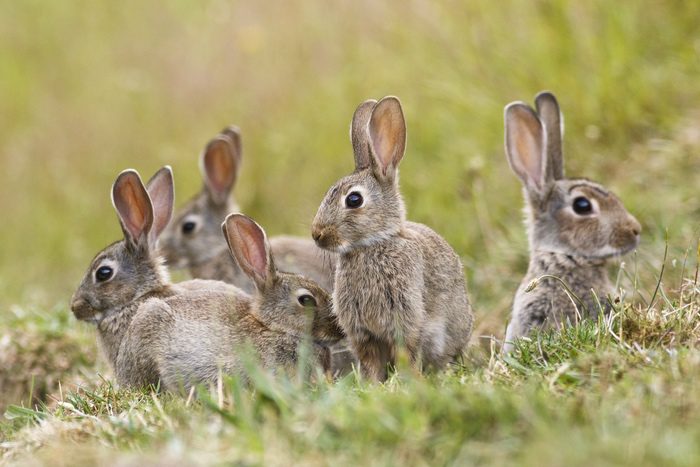
In springtime, the Earth renews itself and the world is full of new life, including baby bunnies. Rabbits generally start breeding in February or March, so a lot of baby rabbits are born as spring flowers are beginning to bloom.4
As they are associated with fertility and springtime, the rabbit is also a symbol of renewal and new beginnings.
The rabbit as a symbol of springtime, renewal, and fertility predates the written word. However, many of us still honor the rabbit as a symbol of new beginnings every year on Easter when the Easter Bunny pays a visit.
So, the rabbit is a positive sign for a new beginning in your life or the opportunity to start fresh.
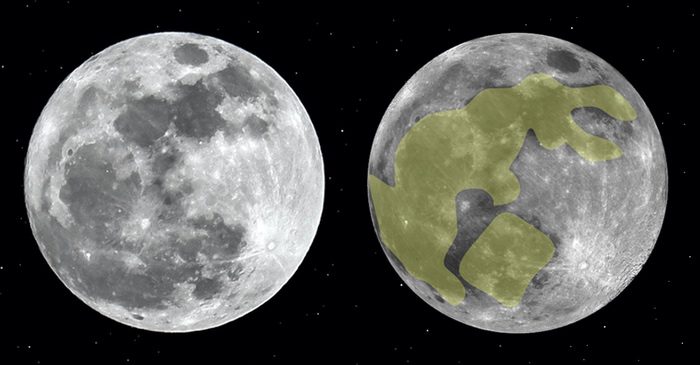
As you’ll read more about in the section on mythology below, in many cultures the rabbit or hare is closely associated with the moon, especially the new moon.
When people from ancient cultures gazed at the full moon, they saw in the shadows of the moon’s craters a shape that looked like a rabbit. In addition, they associated the moon’s 28 day cycle with women’s fertility as they saw the rabbit as a symbol of fertility.
Most likely because they are associated with fertility, abundance, and new beginnings, the rabbit and hare are also symbols of good luck. In fact, at the turn of the century in England, the tradition of saying, “Rabbit, rabbit, rabbit” on the first day of a new month was said to bring good luck.5
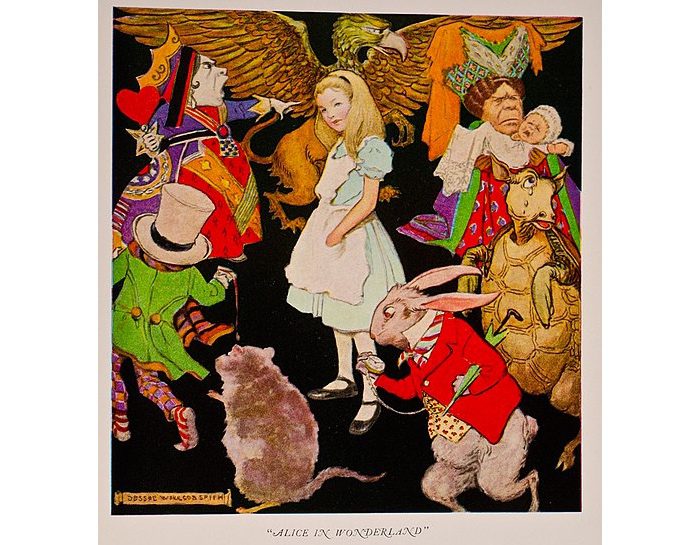
A white rabbit has special meaning in some cultures. For example, British miners had a superstition that if they saw a white rabbit outside of the mine before they went to work, it meant that disaster was imminent.
However, the most common figurative meaning applied to a white rabbit is from Alice’s Adventures in Wonderland. When Alice sees the white rabbit who’s in a hurry, she chases him, falling down the rabbit hole. And this is how her wild adventure begins.
Thus, seeing a white rabbit has come to symbolize the beginning of a life transformation or a new adventure, which opens your mind to new experiences. It can also symbolize a spiritual awakening.
The white rabbit symbol is also referenced in the movie The Matrix and the 1967 song by Jefferson Airplane “White Rabbit,” which some say was about taking LSD.
Like white rabbit, another saying that came from Alice in Wonderland is “down the rabbit hole.” Alice fell down the rabbit hole and entered a wonderful yet bizarre world. So, in popular culture the term has come to mean going after something but getting lost in the process.
Because rabbits live on almost every continent, they are subjects in the mythologies and folklore of many cultures. Here are some of those stories:
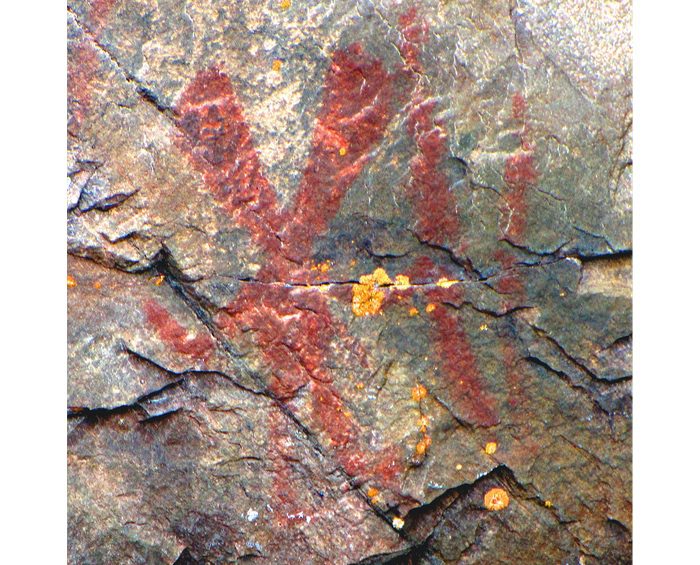
Every Native American culture has their own unique set of customs and beliefs. However, one thing they have in common is a deep reverence for nature and animals. And for many tribes, the rabbit or hare is a benign trickster who can outwit his foes.
The Ojibwe and other Algonquin tribes associate the rabbit with their cultural hero Nanabozho. He is a creator deity who named all of the world’s plants and animals. He is both a spiritual and practical teacher, having taught the people to draw and fish. In addition, Nanabozho is a shapeshifter who often takes the form of a rabbit.6
The Algonquin tribes also talk of another rabbit deity named Michabo. According to Algonquin legends, Michabo was the creator of the world, the chief of all animals, and had the power to create life in others. In fact, he was said to create life from the animals who died, so many of the Algonquin tribes said they originated from animals.7
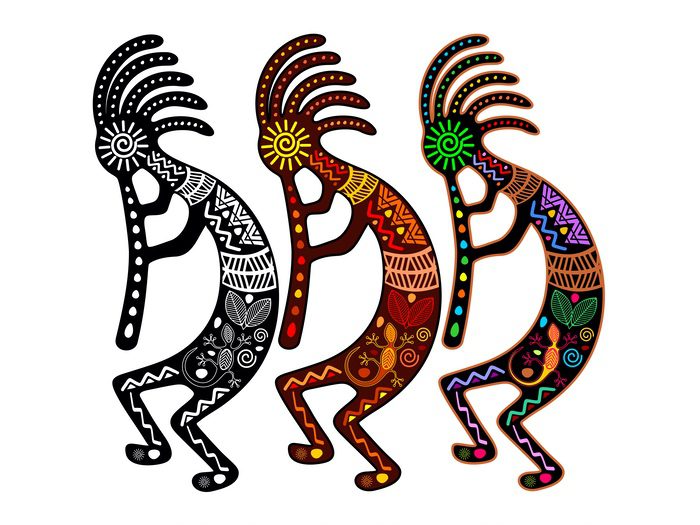
For the Native American tribes of the Southwest, the rabbit or desert hare was a symbol of fertility, rainfall, and prosperity. They were also lighthearted tricksters.
One of the most enduring and common images in Native American art is Kokopelli, the flute player. In some petroglyphs, he is portrayed as a flute-playing rabbit. While the exact origins of Kokopelli are unclear, he is an important cultural figure, appearing in dances, tribal ceremonies, and stories.8
Sometimes Kokopelli is depicted as a fertility god who impregnates women or a guide helping braves to hunt. At other times, he is a rainmaker who helps crops to grow. In some depictions, he looks like he has a big pack on his back. Some historians theorize that he is like a Santa Claus figure, traveling from village to village bringing goods. So, like the rabbit he symbolized prosperity and abundance.
For the Cherokee, the rabbit is also a trickster. However, like the coyote and the crow, he often learns his lesson for causing mischief. One Cherokee legend explains how the rabbit got such a beautiful fur coat but has no tail.
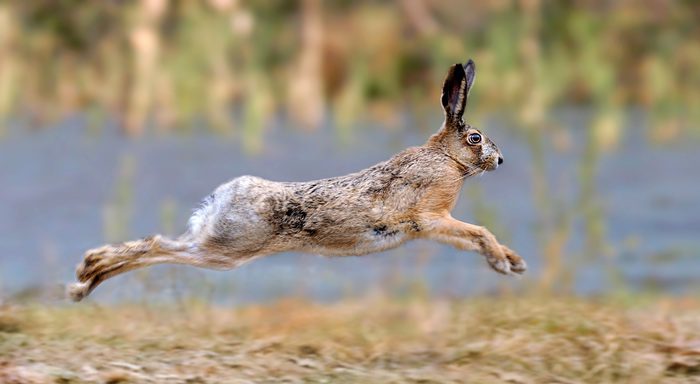
The animals were holding a council meeting and they wanted Otter to come. Otter was known for his beautiful coat, which the other animals loved to see. But he preferred to stay in the water and didn’t like going to meetings. However, this time Rabbit said he would convince Otter to come.
So, Rabbit invited Otter to the council meeting, telling him that they had to make an important decision and he would be the tie breaker on the vote. Then Rabbit told Otter that he would show him the way to the meeting since the territory would be unfamiliar to them.
On their journey, when they took a break for the night, they saw many shooting stars. Rabbit told Otter that in that part of the world, the stars often fell from the sky and set fires. “But don’t worry,” the rabbit said, “I’ll stay awake and if there’s fire, I’ll yell and you can run and jump into the river.” Then he added, “But you should hang your coat on this branch before you go to sleep where I can watch it and grab it so it doesn’t catch fire.”
Once Otter fell into a deep sleep, Rabbit yelled, “Fire!”
Awaking with a start, Otter jumped up and ran into the river. Then Rabbit grabbed his coat from the branch, put it on, and ran away.
When Rabbit arrived at the council meeting, at first everyone thought it was Otter. But as he got closer, the animals saw Rabbit’s big ears and back feet and knew he had stolen Otter’s coat. Enraged that he would trick Otter in such a way, Bear rose up and started growling. Rabbit got up to run away, but not before Bear swiped off his tail.9
Most Native American tribes are based around a clan system, which is a form of community organization that’s rooted in the maternal family line. Each clan is associated with a specific animal who serves as a guardian and protector of the members of the clan.
Examples of clan animals include the hummingbird, bear, fox, wolf, otter, and mountain lion. Native American tribes with rabbit clans include the Hopi and the Shawnee. In addition, the Northeastern and Northern Plains tribes do a sacred Rabbit Dance.10
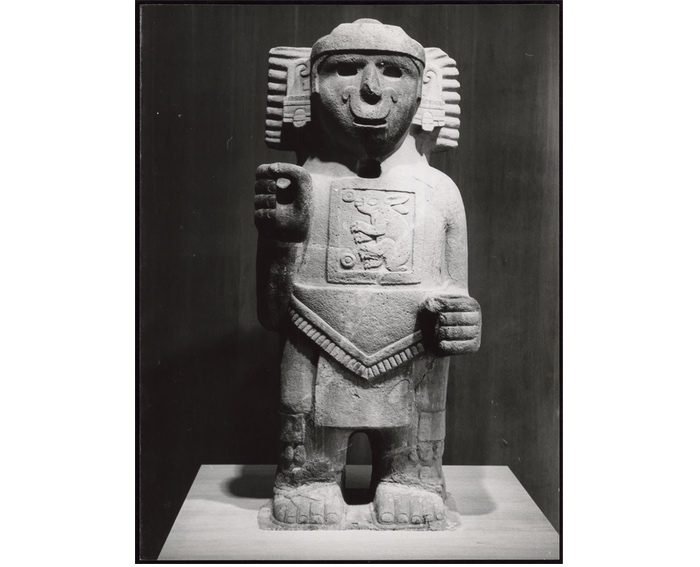
For the Aztecs, the rabbit symbolized fertility, drinking, and parties. The Aztecs told stories about the Centzon Totochtin, which consisted of 400 rabbit gods.11 One of the 400 gods was Macuiltochtli.12 He ruled both over-indulgence and the consequences of over-indulgence.
One Aztec legend tells the tale of how there came to be a rabbit in the moon.
One day, the god Quetzalcoatl wanted to explore the world of humans, so he turned himself into a man and went down to Earth.
In his wonder and excitement at seeing the world up close, Quetzalcoatl forgot to eat and drink. So, he took a rest on a log. Eventually, a rabbit came to him and said, “You look thirsty and hungry. Can I share my food with you?”
Quetzalcoatl was impressed with his generosity, especially because the rabbit had no idea he was a god. However, Quetzalcoatl declined because, he said, “I only eat meat.” Seeing how hungry he was, the humble rabbit said, “Well, you can eat me.”
With this offer, Quetzalcoatl was so moved that he returned to his god state. He then picked up the rabbit and pressed him against the moon. He said, “You are so noble that I will not eat you. And from now on, when people look at the moon they will see your imprint and be reminded that you are a mighty being, full of honor and generosity.”13
Evidence of the ancient Egyptians celebrating springtime in ways that are similar to how many of us celebrate Easter today dates back to at least 2300 BC.
The Egyptians depicted hares, eggs, and the sunrise together, along with the resurrection of their god Osiris, in the Book of the Dead and other hieroglyphs and artwork.
The Egyptians told stories of their sun god Ra emerging from an egg and then rising as the sun. By association, Osiris (the grandson of Ra, overlord of the Underworld, and assessor of souls) shares symbolism with Ra. Likely, this is because he was killed and then resurrected as the god of the Underworld.14
Of course (as we sometimes have to remind little kids at Easter) – rabbits don’t lay eggs. However, both are clearly fertility symbols, thus symbols of renewal, so it’s easy to see their long enduring association.
In addition, the Egyptians had a goddess named Unut (or Wenet) who was depicted as part-snake or part-hare. Furthermore, the Egyptians had other hare deities, including one who guarded the halls of the underworld.
In a number of African cultures, the hare is depicted much in the same way as in Native American cultures. That is, the hare is a mischievous trickster. In fact, one African folktale was the precursor to the American story about Brer Rabbit.
Another story called The Hare and the Lion tells the tales of a hare who continuously outsmarts and escapes from a lion who wants to eat him. In one part of the story, the hare cajoles a turtle to climb a tree with him to get some honey. As the two are eating the honey, a lion comes growling, asking who is in the tree.
The hare convinces the turtle to wrap him up in leaves. Then he tells the turtle to tell the lion to move aside, that he’s going to throw some leaves down before he comes down from the tree. So, the lion gets out of the way. Once the hare bundled in leaves hits the ground, he sprints away, leaving the turtle alone to deal with the lion.
Not to be outdone. The turtle tells the lion that he can eat him. However, first he must take him to the river. The turtle then tells the lion to rub his shell to make it come off, so it will be easier to eat him. However, under the water, the turtle puts a rock under the lion’s paw and the lion keeps rubbing the rock as the turtle escapes.15
The Greeks associated the hare with the goddess of love, Aphrodite. Thus, in Greece, the rabbit was a symbol of fertility, virility, and desire.
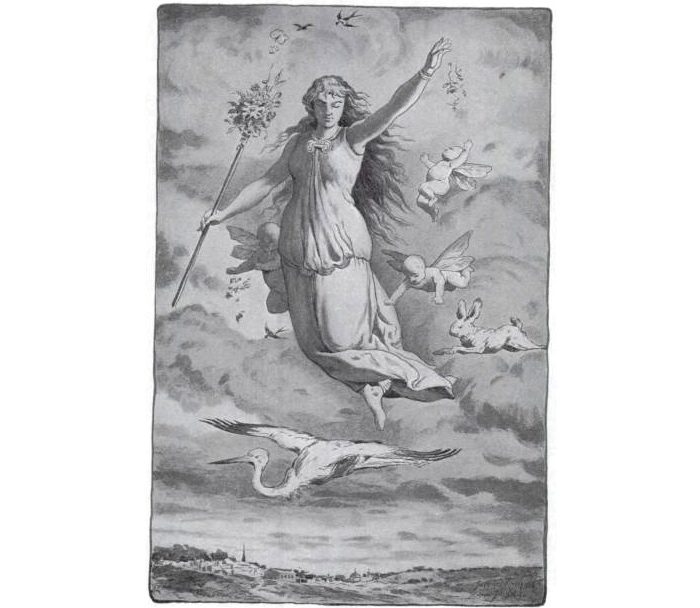
The Celtic goddess Eostre was often depicted with rabbits, as was the goddess Ceridwen. Eostre is a fertility goddess who’s associated springtime, in particular the Spring Equinox, as well as the dawn. Thus, many people believe the name for Easter is derived from Eostre. Ceridwen was the goddess of transformation and rebirth.
Just as the Romans would interpret the flight patterns of ravens, the Druids used rabbits as a source of divination. They would catch rabbits, release them, and then interpret the direction the rabbits took.
The Celts also associated rabbits with fairies, believing the two communicated when they were underground. The Celts also believed certain people could shapeshift into rabbits, thus they had taboos about killing them.
In one Celtic myth, the hero warrior Oisin chases a hare and hits it in the leg with his arrow. The hare manages to escape into the woods and goes through a door in the ground. Oisin pursues the hare, eventually finding himself in a great hall where a beautiful woman is sitting on a throne with her leg bleeding.
In another story, a maiden named Melangell decides she will live the life of a monk and takes a vow of celibacy. She travels to the town of Powys where she lives a hermetic life for 15 years. One day, when the Prince of Powys is hunting hares with his hounds, he chases one into a thicket. Then he comes to a clearing to find the hare sitting in Melangell’s lap.16
The prince is so impressed by Melangell’s spiritual devotion and the trust of the hare that he gives her land to build a monastery. He tells her that the only thing she must give in return is to promise that she’ll give refuge to both people and animals.
The Vikings associated hares with the moon as well as their fertility goddess Freya. In addition, the Norse goddess of domesticity, Holda, was sometimes depicted as riding a chariot pulled by hares.
Rabbits are mentioned in the Bible, but mainly in context to whether they should be eaten or not. However, later Jewish scholars, such as Rabbi Yosef Hayim Yerushalmi, viewed rabbits running in every direction as a symbol for the Jewish Diaspora.17 In addition, the three hares symbol, which is detailed more below, is depicted on Jewish synagogues and was adopted by Christians as a symbol for the Holy Trinity.
Early Christians commandeered the pagan view of the rabbit as a fertility symbol and instead associated it with springtime and the resurrection of Christ.
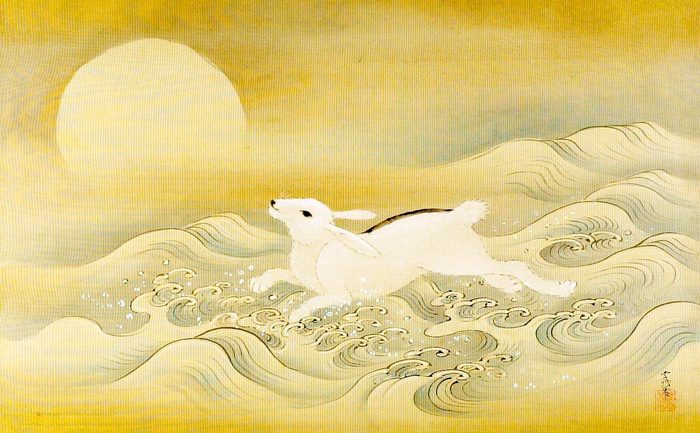
The Japanese also associate rabbits with the moon. In fact, they have a story that is practically identical to the Aztec story about the rabbit and the moon. In the Japanese version, the Man on the Moon comes to Earth and he is very hungry. Like the Aztec story, the rabbit offers himself to be eaten. But the Man on the Moon is so impressed with the rabbit’s generosity that he doesn’t eat him and instead brings the rabbit to the moon to live with him.18
The Chinese, Koreans, and Vietnamese also associated rabbits with the moon. The Chinese viewed the rabbit as an incarnation of the moon goddess.
In addition, in Chinese astrology, people born in the Year of the Rabbit are said to be gentle, approachable, honorable, and elegant.
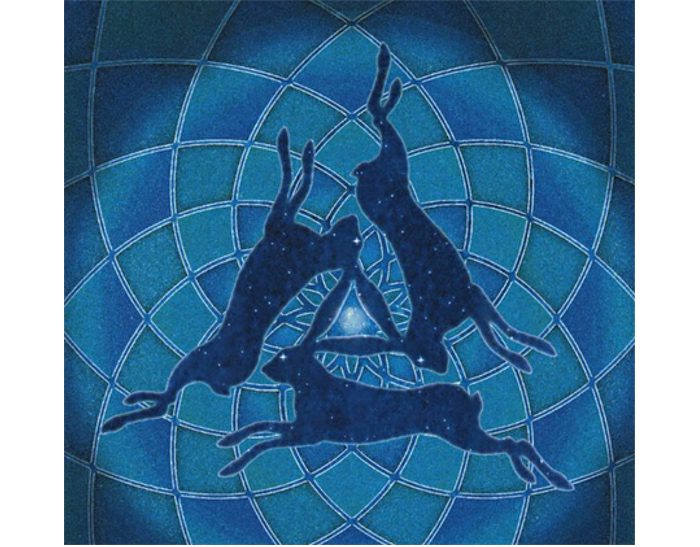
The symbol of three hares chasing each other in a circle is a motif that appears in artwork from ancient China to Mongolia to the Middle East, Europe, and beyond.
Historians believe the first instance of the symbol dates back to the 6th century. It was discovered in the sacred Buddhist Magao caves near the ancient town of Dunhuang. The town was located along the Silk Road, so travelers who saw the symbol inevitably brought it home with them, putting it on artwork, pottery, tapestries, coins, and so forth.
No one knows for sure what the original symbol means. Some say it has similar meanings to an ouroboros. Others say it represents the cycles of the moon and even the cycle of life. Indeed, the motif appears in context to a number of spiritual beliefs, from Buddhism to Christianity, Judaism, and Islam.19
The Indians tell a tale that’s similar to the one told by the Aztecs and Japanese about why it looks like there’s a rabbit in the moon. In Hindu mythology the moon is associated with femininity, well-being, and happiness.20
In some Buddhist stories, Buddha is said to have been a hare in an earlier incarnation. And apparently he traveled in in the company of an ape and a fox.
The three rabbits symbol also appears in Buddhism. Some say it symbolizes tranquility. However, others say it symbolizes samsara, or the wheel of karma, which we spin on lifetime after lifetime until we reach enlightenment.
In some cases, the three hares are depicted with a lotus flower or lotus petals, which may imply that it symbolizes the cycle of reincarnation and then spiritual enlightenment.
In Buddhism and other Eastern philosophies, the rabbit is associated with fire. As a symbol of fire along with being a symbol of renewal and rebirth, the rabbit shares symbolism with the phoenix.
In the U.S., we have incorporated the rabbit as a trickster into popular culture. One example, which is based on Native American traditions, is Bugs Bunny who perpetually plays tricks on Wile E. Coyote. Another is the story of Brer Rabbit, which is based on African folktales.
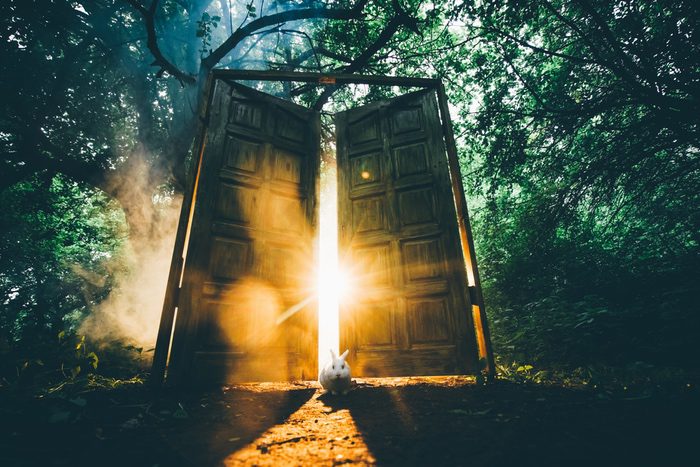
Whether you already know the rabbit is one of your spirit animals or if one suddenly makes themselves known to you in real life, the media, or art – pay attention. There are no coincidences.
Like crocuses bursting through the snow in early springtime, the rabbit spirit animal reminds you that there is hope and new opportunities on the horizon. As a symbol of renewal, the rabbit also reminds you that everything that is old can be new again. After all, rabbit people have the capacity to spring into action and begin anew.
If you’re curious about other spirit animals who might also be your guides, you can take UniGuide’s What Is My Spirit Animal Quiz.
As the name implies, a power animal can empower you with their most dynamic traits.
So, if you want to transform an area of your life, consider the attributes that the power animal represents. For example, you can meditate on the rabbit power animal when you:
An animal totem embodies the protective powers of the animal it represents. Thus, the rabbit totem serves as a helpful symbol for good luck, fertility, and abundance. It’s also a helpful symbol if you want to be quicker on your feet or get results from something faster. In addition, the rabbit totem is a helpful symbol for creating more gentleness in the world.
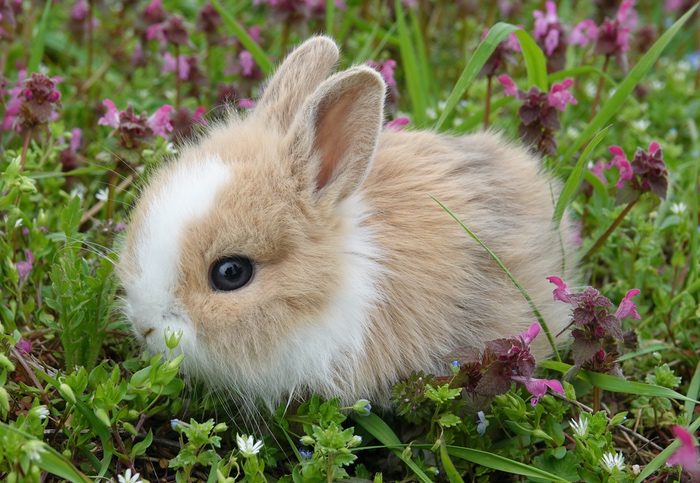
What does it mean if you dream of a rabbit or rabbits? Dreams are personal to each dreamer. However, the rabbit is such a renowned symbol for fertility and abundance, it’s worth considering those concepts in context to your dream.
Dreams can be the result of fears or anxieties about issues that we need to address in our conscious, wakeful state. Or they can be our brain’s way of imagining pleasant experiences. Your dreams can also be messages from your spirit guides and other information that you pick up metaphysically.
Bunnies are gentle creatures, so hopefully your rabbit dream was not the nightmare variety. While dream meanings are personal to the dreamer, hopefully having a greater understanding of rabbit symbolism and mythology can provide more insights into what your dream is telling you.
A rabbit or bunny tattoo can be depicted in a wide variety of ways, especially because these animals have symbolic meaning in so many cultures around the world – past and present. A rabbit tattoo can show the world that you’re a gentle person. It can also mean you were born in the Year of the Rabbit. In addition, it can be a celebration of spring or other new beginnings.
The symbol of the three rabbits would also make an intriguing tattoo. You can apply your own meanings to the symbol as the original meaning is still quite mysterious.
Of course, tattoo meanings are deeply personal to the individual who has the tattoo. But hopefully understanding more about rabbit symbolism and mythology can bring even deeper meaning to your tattoo.
Although they are symbols of fertility and thought to be prolific breeders, the fact is that nearly half of the world’s rabbit species are in danger of extinction.21 Threats to wild rabbits include loss of natural habitat, predation by domesticated dogs, and the wildlife trade.
In addition, rabbits are exploited for their fur, as food, and in scientific experiments, notably by the medical and beauty industries. Furthermore, shelters take in thousands of rabbits every year, the majority of which are from pet owners who surrender them because they cannot or don’t want to take care of them anymore. It’s a sad fact that around Easter, people impulsively buy rabbits to give to children without considering the longer term implications of keeping them as pets.
If you care about rabbits, please do what you can to protect them. Here are some resources and organizations focused on rabbit conservation and welfare:
You might enjoy these other articles on UniGuide:
UniGuide is dedicated to nature and animal lovers, spiritual seekers, and mythology fans.
©2026 UniGuide Media LLC
All Rights Reserved.
UniGuide participates in affiliate programs in which I may earn a small commission if you buy products you link to from UniGuide. Please see my Disclosures for details.
I donate 10% of UniGuide’s profits to animal welfare, wildlife conservation, and environmental charities. Learn more on About UniGuide.
UniGuide Media LLC
Sausalito, CA 94965
| Cookie | Duration | Description |
|---|---|---|
| cookielawinfo-checkbox-analytics | 11 months | This cookie is set by GDPR Cookie Consent plugin. The cookie is used to store the user consent for the cookies in the category "Analytics". |
| cookielawinfo-checkbox-functional | 11 months | The cookie is set by GDPR cookie consent to record the user consent for the cookies in the category "Functional". |
| cookielawinfo-checkbox-necessary | 11 months | This cookie is set by GDPR Cookie Consent plugin. The cookies is used to store the user consent for the cookies in the category "Necessary". |
| cookielawinfo-checkbox-others | 11 months | This cookie is set by GDPR Cookie Consent plugin. The cookie is used to store the user consent for the cookies in the category "Other. |
| cookielawinfo-checkbox-performance | 11 months | This cookie is set by GDPR Cookie Consent plugin. The cookie is used to store the user consent for the cookies in the category "Performance". |
| viewed_cookie_policy | 11 months | The cookie is set by the GDPR Cookie Consent plugin and is used to store whether or not user has consented to the use of cookies. It does not store any personal data. |
8 Responses
Thanks for this most informative post on hare/rabbit folklore thru the ages.
“…Statue of the Egyptian rabbit goddess Unut.” Um, no, that photo looks more like the lion Goddess Sekhmet, unless a dedication on it states otherwise.
It would be interesting to know -why- hares/rabbits represented Osiris. I can understand them being guardians of the Underworld due to their living underground.
Thanks for the feedback on the image, Heather. I stand corrected. I also updated the section on Osiris. If you want to learn about something that’s pretty mind-blowing about Egyptian mythology and just how advanced their culture was, check out Sacred Geometry on the Gaia channel on Amazon Prime. I found it fascinating!
Last night, driving home a wild rabbit ran towards my car. Instead of running back as I got closer he ran into the car. As I passed I heard 3-4 bumping sounds, as was certain that I killed him.
I stopped and circled back to find out. To my surprise he was sitting tall by the side of the road staring at me. We looked at each other for about 10-15 sec and then he ran away.
I’m trying to integrate the meaning of that experience.
Thank you
I am relieved to hear that he/she wasn’t killed and hopefully not hurt too badly. I’m also heartened to hear that you checked on him (or her.) I think when you look into the eyes of an animal – there is a soul connection. Many of us who love our pets know this. With wild animals, it’s less common, so it’s especially profound. I believe you have a mutual understanding that you are kindred spirits.
Same thing happened to me 😭there was 2 rabbits they run to me when I was driving I try to stop but they run in my direction, I didn’t stop but been thinking about it 🥺 and they were so cute so beautiful
ive been seeing a white rabbit everyday for the last month. I have to believe that this mean something since my life is completely out of control. Thank you
That’s interesting! I went through a phase like that. Keeping clear on a vision for what I wanted in my life, or simply some reachable life goals, helped me to navigate better and, as the saying goes, to not swear the small stuff. Best of luck to you!
I am very sorry to hear this. Do you have any idea how he died? Since he was so young, it’s worth trying to figure out how he died, if that’s possible. I would ask your veterinarian. I think that could help to give you closure. On a spiritual level, souls have different time lines for how long they’ll be here on Earth, so death in and of itself is a natural process, obviously. But when people or animals die young and/or suddenly, I think it’s important to try to figure out why that happened. Also, we think of dogs and cats as shelter animals, but there are also other animals, such as rabbits and guinea pigs, in shelters who need loving homes. When you are ready emotionally, this can be a way to honor your pet how has passed – by caring for one who is here and needs a loving home. Take care!